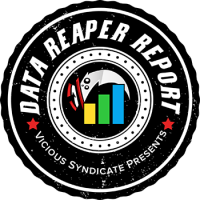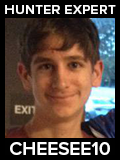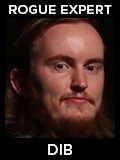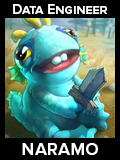
Welcome to the 134th edition of the Data Reaper Report!
Our Data Reaper Project, including the Data Reaper Live has 4,800 active contributors and we thank them wholeheartedly. Contributing to the Data Reaper project through Track-o-Bot or Hearthstone Deck Tracker (recommended) allows us to perform our analyses and to issue the weekly reports. Without the community’s contribution, there would be no project. Contributing data is very easy and takes a few simple steps, after which no other action is required. If you enjoy our content and would like to make sure it remains consistent and free – Sign Up!
Quick Links
Class/Archetype Distribution | Class Frequency | Matchup Winrates | vS Power Rankings | vS Meta Score | Class Analysis & Decklists | Meta Breaker of the Week | How to Contribute | Credits
Number of Games
| Overall | 40,000 |
| Legend | 7,000 |
| Ranks 1-4 | 16,000 |
| Ranks 5-9 | 13,000 |
| Ranks 10-14 | 3,000 |
Class/Archetype Distribution
[TABS_PRO id=21401]
Class Frequency
[TABS_PRO id=21402]
Class Frequency Discussion
While there are still some significant movements in the meta, things are beginning to settle down and take shape. Hunter, the most popular class in the game, is stabilizing around its two primary archetypes (Bomb, Midrange), with a modest presence of Secret Hunter.
Mage is continuing to increase in popularity thanks to its high profile tournament and ladder success. Cyclone Mage is the most popular deck at higher levels of play. Freeze Mage and Specters Mage aren’t nearly as influential, but they’re sticking around.
Warrior is increasing in popularity outside of legend, as word of its success trickles down and more players come to recognize the class’ ladder efficiency. Control Warrior is slightly more popular than Bomb Warrior at the 1-4 bracket, where aggressive decks are generally more frequent, especially Bomb Hunter.
Rogue is in decline, as enthusiasm for the slower archetypes of the class (Shark, Pogo) is waning due to their performance level on ladder recently. However, Party Rogue is trending upwards and is significantly more popular at legend.
Reality has set in for Aggro Shaman players. The deck’s Warrior matchups, which are becoming increasingly more frequent, are extremely painful. This trend is heavily dissuading players from piloting Aggro Shaman on ladder, leading to its decline. Murloc Shaman isn’t suffering from the same effect, as it’s better equipped to deal with Dr. Boom.
Paladin’s decline is slowing down, and Mech Paladin has even grown in popularity at legend. The deck is very tempting to run into Warriors, since it smashes them like no other deck. Holy-Wrath Paladin remains at a lower play rate, and it’s unlikely to grow in popularity since it struggles in these Warrior matchups.
Druid and Priest are in a similar spot as they were last week. Druid can do one good thing effectively, which makes it a relevant competitive option in the meta, but not much else. Priest can do a lot of different things, but none of them are any good. Don’t expect any surprises from these classes until the next expansion.
Warlock might be the saddest class in the game as the only reason to play Zoo Warlock at the moment is for the sake of playing Zoo. The archetype has no real role in the meta, is outclassed by a multitude of better options, and is therefore stuck at a low play rate that’s probably higher than it should be.
[TABS_PRO id=21403]

[TABS_PRO id=21404]
vS Meta Score
[TABS_PRO id=21405]
vS Power Rankings Discussion
There is a “flattening” of win rates at higher levels of play, where the best decks are declining towards the 52% win rate mark. This suggests that the meta is beginning to effectively respond to the most offensive elements, which are Warriors. Both Control Warrior and Bomb Warrior have declined in their win rates at most levels of play. They are obviously still two of the best decks in the game, but this week’s results suggest that there is an effective process to keep them in check. Warrior is not spinning out of control.
Objectively, the current meta isn’t particularly imbalanced. We’ve seen much worse, considering that the best deck at legend exhibits neither an oppressive win rate nor an alarmingly high play rate. We do like to meme about the best decks often, but it’s to add a bit of flavor to our reports. It’s not necessarily a complaint.
Bomb Hunter is showing a high power level outside of legend, but it’s a deck with a noticeably low skill ceiling: stronger players are much more effective at playing against it, and we see it in multiple matchups across the board. At higher levels of play, it’s not nearly as dominant.
Warrior is the strongest class once we reach the highest levels, and it’s the class that most players complain about. Mad Genius is definitely an extremely powerful hero card that displays the performance level of a nerf candidate. If Warrior’s play rate was truly overwhelming, it would probably be first on the list to be nerfed. But if we’re strictly being realistic, we guess that it’s unlikely to be changed at the game’s current state despite its very high power level. Remember that hero cards have never been nerfed before.
Let’s try to look at it from a different perspective, too. Team 5 might be worried about the outcome of nerfing Warrior, opening the way for an extremely aggressive meta to step into the void. Aggro Shaman, for example, could become a massive problem in this scenario. It’s a “dangerous” deck with a game plan that’s not particularly “fun & interactive.” Every nerf has consequences, and they are difficult to predict, so balance changes involve a lot of thinking and perhaps, meta simulations.
Alongside Warrior and Bomb Hunters, we still see Secret Hunter sticking around at a good performance level, especially at legend. The cause is its Cyclone Mage matchup, a deck that is much more popular at higher levels of play. Secret Hunter wins this matchup quite convincingly.
Meanwhile, Midrange Hunter looks significantly inferior on ladder compared to other Hunter decks. Its problems stem from an ongoing struggle against Rogue, its disadvantage in Hunter mirrors, and the Bomb Warrior matchup proving to be surprisingly difficult.
Cyclone Mage is displaying some very interesting results. Outside of legend, it’s very lukewarm, hovering around the 50% mark. At legend, its win rate is spiking towards the top end of the table. There are a few causes for this:
Cyclone Mage has a high barrier of entry, meaning that it takes more time for a player to initially become acclimatized to the deck compared to other strategies. As the deck increases in popularity, it takes more of these new players in, and that negatively affects its performance. We can see it in multiple matchups, especially against aggressive decks and Warriors.
Cyclone Mage currently runs quite a few “trap tech cards.” Cards such as Doomsayer and Astromancer are tempting options in order to improve a specific matchup but they’re not actually worthwhile overall. Players at higher levels are just as susceptible to be lured by trap cards, but they’re also the first ones who have started to cut them from Cyclone Mage, finally.
Cyclone Mage has a relatively higher skill cap (high performance potential compared to its basal win rate). It doesn’t seem as high as other standout decks we’ve seen in the past, but it’s certainly noticeable enough to make some impact on its win rate.
Party Rogue’s rise in play at legend isn’t an accident. The nerfed archetype is proving to be the strongest Rogue deck available, with a matchup spread that is impressive all around. Players tend to shy away from decks that have been nerfed, and we’ve seen many example in the past where those nerfed decks still performed extremely well, but they never neared the same play rates as before (Cube Warlock, Even Paladin). The players who have stuck with Party Rogue are certainly being rewarded for it.
Hooktusk Rogue performs better against aggressive decks than Party Rogue, but it is completely crippled by the might of Dr. Boom at higher levels of play. Party Rogue has a better chance at winning these matchups, and can also hard-tech for them in extreme Warrior environments.
Shark Rogue does a lot of cute value things, but those cute value things don’t actually translate into a better performance against Warrior than Party Rogue. And, those cute things certainly don’t help the deck in any other matchup. For ladder, at least, Shark Rogue’s versatility is more of a hindrance than an advantage.
Pogo Rogue continues to improve in its performance, but it still has a long way to go. We doubt that it will settle down at a strong enough win rate, even when we discount the more meme-heavy builds.
The rise of Warrior is making Aggro Shaman bleed, something that was relatively easy to see coming. Murloc Shaman is just a more suitable choice to handle the current meta and is a more flexible deck that can adjust better to a particular opponent.
Mech Paladin may lick its lips at the rise of Warrior but bites them at the sight of Mage. That ongoing rise of Cyclone Mage is offsetting any benefit that Mech Paladin can gain from encountering Warriors.
While Token Druid is surviving, and Zoo Warlock stands on its last legs, Priest has completely disappeared from the Power Rankings. No Priest deck has a high enough play rate to evaluate. Take that, Mind Blast!
Class Analysis & Decklists
Druid | Hunter | Mage | Paladin | Priest | Rogue | Shaman | Warlock | Warrior
Continuing the trend from last week, we’ve seen an uptick in Mage’s play rate on the back of the class’ recent tournament success, as well as high legend ladder success.
Not much has changed in terms of what we consider to be the best builds. Luna’s Pocket Galaxy has almost completely taken over and is heavily used by every archetype of the class. Cyclone Mage has some flexibility in terms of tech choices, but a well-rounded list should be the most consistent performer. Arcane Keysmith is becoming more popular in Freeze Mage since it’s useful in the deck’s worst matchups against aggressive decks such as Aggro Shaman and Bomb Hunter.
With Cyclone Mage continuing to increase in popularity, Secret Hunter is likely the most underrated deck in the current meta. It’s a great choice if you really want to bring the pain to Mages. We’ve also noticed that with the increasing popularity of Mages and an overall decline in weapon tech, Eaglehorn Bow is becoming a stronger card, so after looking fairly underwhelming for a long time, we’ve added it back.
Both Bomb Hunter and Midrange Hunter have been pretty much refined. Headhunter’s Hatchet is the most common tech available to Midrange Hunter if the meta is aggressive, but we dislike cutting Deadly Shots for it due to the increasingly popular Cyclone Mage matchup. If you do want to run Hatchet, cutting Marked Shots is a better alternative.
Warrior is the best class in the game. It’s hard to argue against it, considering how strong both Control Warrior and Bomb Warrior are on ladder. Theo has been consistently hitting #1 legend with the featured Control Warrior build for the last few weeks, and the deck is just extremely consistent. Bomb Warrior is also very powerful, and more versatile than Control Warrior, which is why it is nearly always the archetype of choice in the tournament scene. We’ve seen some experiments with Bomb Warrior builds that are faster, cycle heavy, or more aggressive, but for now, they look strictly inferior to the standard Bomb Warrior.
Party Rogue is the strongest Rogue deck for ladder play. It performs well against every ladder opponent with the exception of Warriors and Token Druids (the balance changes did affect the Druid matchup quite a bit). The Thug build is what you generally want to run for ladder, with the Nomi option worthwhile only when the field is heavy with Warriors. It provides about a 10%+ increase in the Warrior win rate, at the cost of most other matchups. Another card that can be considered is Faerie Dragon, which is a strong Mage tech.
Hooktusk Rogue is the best anti-aggro option in the class. It performs exceptionally well against faster decks since it’s very effective at beating them off the board. It also has a very effective finisher, with Hooktusk offering an oppressive turn against any deck that doesn’t run strong AOE. The big problem that limits Hooktusk’s potential is Warrior.
Shark Rogue may still be very popular in tournaments, but its ladder performance is still quite underwhelming. The fact that it’s slower (compared to Party Rogue) worsens its Mage and Hunter matchups because it gives them more time to stabilize and execute their power plays. Spirit of the Shark isn’t impactful enough in the Warrior matchup either. It’s very comparable to Astromancer’s performance in Cyclone Mage, and the reasoning for the exclusion of both cards is very similar. Cards that gives you a measly ~5% against one class while sinking your performance against the rest of the field just isn’t worth it in a ladder environment. Their performance needs to be more dramatic in that one matchup (such as MUE/Nomi) or that matchup needs to be much more popular to justify them.
We’ve added a build that does include Spirit of the Shark, in case you were wondering how we’d build the deck with it for ladder. The most important thing to note is that Novice Engineer is being widely preferred over Eviscerate, but that also looks like a clear mistake. The battlecry synergy is baiting players to add the 2-drop, but its effectiveness is far weaker than it’s perceived to be. Much like Shark, it’s a very weak standalone card and it makes no sense from both a statistical perspective as well as just a logical perspective to add it to the deck over a card that has proven to be strong in nearly every Rogue deck, for years.
Pogo Rogue has seen some developments with Fr0zen hitting top 10 legend with his build, which runs Jepetto Joybuzz and SN1P-SN4P. This deck runs even more draw options than our featured build, something that we definitely like since Pogo Rogue is so dependent on its drawing power. The painful concession in his build is the singular Sap and Vanish (which will eventually have to be replaced once it goes into the HoF). The reason these concessions can be painful are the Mage matchups. Mage is a big barrier for Pogo Rogue’s ladder success due to its freeze effects and (literally) giant swing turns, while Fr0zen’s build is geared more heavily to perform against Bomb Warrior with Harrison Jones.
Shaman is in decline as the more popular classes seem to be pulling away. While Aggro Shaman does enjoy the rise of Cyclone Mage, this is offset by the overbearing presence of Warriors, which are a very painful experience.
Perhaps, the one thing keeping Aggro Shaman from becoming a truly dominant deck is its early game minion development. The fact that Underbelly Angler is one of the deck’s stronger options, despite running little support for it, says a lot. We’ve seen players experiment with Crystallizers, but they’re pretty weak unless they’re played specifically on turn 1. Thrall is missing his Tunnel Trogg and Totem Golem, though we certainly don’t mind: Aggro Shaman would likely be broken with those cards added in.
Murloc Shaman is the better Shaman deck in the current meta. While it performs worse in faster matchups, it stands a much better chance against Warrior, and can adjust to the matchup in a more meaningful way. For example, Ghost Light Angler is a great tech against Warriors.
Paladin has been reduced to a fringe class. Although Mech Paladin performs well enough to be competitive, the polarizing nature of the deck seems to be off-putting. It’s also likely that the rise of Mage is discouraging players from picking it up, since Paladin is a sitting duck for Mage’s stalling tools.
We did find a couple of interesting developments for Mech Paladin. One card that’s growing in popularity is Faceless Manipulator. While the initial instinct would be to write it off as a “win more” card against Warrior, it’s surprisingly effective against Mages and Hunters, to the point where its inclusion has serious merit. WaningMoon’s high legend build also features Spellbreaker, which can help the Paladin get past taunts in order to connect its big minions to the face.
Druid has one way to play the game, and most players are bored with it. It is interesting that due to the lack of attention towards the class, Token Druid hasn’t made adjustments it should arguably make. For example, Sea Giants are very uncommon at the moment, but they’re very strong. Last week’s adjustment, where we added back The Forest’s Aid in order to assist the Mech build against Warrior, seems to have hit the spot. The featured build should perform as well as Token Druid can in the current meta.
The Priest class is lost. It has so much experimentation with different archetypes that it’s difficult to tell what you’re up against when encountering a rare Anduin on ladder. What you can tell is that you’re likely to win, because you’re facing Priest.
To add insult to injury, Priest is losing Mind Blast, one of the only win conditions available to Priest in the classic set (the other one is Inner Fire). Prophet Velen is also turning into a 1600 dust War Golem as a result. Let’s be clear: we don’t particularly mind this specific step from a macro perspective. We understand the thinking behind it. The loss of Mind Blast just happens to be ironic considering the state of the class and specifically its classic set.
Also, there is a future concern when it comes to Priest’s design. Historically, Mind Blast has been part of the strongest Priest decks in Hearthstone’s history, because it provides a reliable finisher that can end the game, something that good late-game strategies normally have. The most notable exception is Big Priest, an archetype that we know is universally loved by all Hearthstone players due to its fun resurrection mechanics. Right?
Our point is that attrition-focused Priest decks have rarely been strong, but whenever they are remotely strong, they’re hated with the heat of a thousand suns. That’s because attrition decks have an inherent disadvantage against finishers, and for them to be strong, they need to carry overwhelming resource generation or armor gain to outlast these finishers, and that’s a playstyle that’s particularly difficult to strike a balance with: power level wise, and fun wise. The question becomes, is Priest allowed to have “finishers”? If it doesn’t, then we fear that its boom/bust cycle will be even more polarizing than before.
This week is more of the same for Warlock. Zoo Warlock is at a depressingly low play rate and win rate. With Warrior developing a solid foothold in the meta, Gul’dan will likely have to wait for the next expansion to find relevance. Right now, there are just better aggressive decks in the meta than Zoo.
Currently, the deck that is making the most strides in its play rate and its win rate (at legend) is Cyclone Mage. We have mentioned that Cyclone Mage shouldn’t be over-teching for matchups, and needs to be consistent in its own game plan.
For example, it’s very common for players to run one Banana Buffon, but it’s incorrect. Banana Buffoon fuels the power plays available to Mage in the early to mid-game (Giant/CC, Sorcerer/Cyclone) quite perfectly. Cards such as Doomsayer, Rabble Bouncer and Mind Control Tech are far too passive to fit the deck’s game plan consistently. Even against aggressive decks, the best path to victory comes from your own power plays.
Astromancer is a narrow tech that became popular due to the introduction of Galaxy and the temptation to beat Warrior, but it’s terrible in your faster matchups while your Warrior matchup should be good enough without them. The key to success against Warrior (if the game goes late, because you can still beat them early) is to spread your resources and set up an unanswerable turn through either Antonidas, Khadgar/CC or Alexstrasza.
As we’ve said earlier, this deck does have a barrier of entry. It’s not easy to pick up and immediately do well with, but it is rewarding to learn.
Our Data Reaper Project, including the Data Reaper Live has 4,800 active contributors. Without them, this project would not be possible, so we’d like to thank all of our contributors for their help.
Preparing our weekly article requires a significant amount of time and effort from many individuals. We would like to wholeheartedly thank our current Patreons, whose generous donations help us fund computing and server costs.
vS Gold is a new membership plan aimed to support our efforts towards improving our content and data analysis while receiving some bonuses and extra features.
Tier 3+ Patrons
Special thanks to Leo G, Aaron B, Jed M, Drew M, Alan J, Eric L, Zolstar, Sean H, Steve F, Andrew N, NObdy, Mark S, Alonso P, msKang, James Y, PinkMageDiaries, Je-ho, Ziqiao Y, Stephen H, William H, Mark P, and Patrick L for supporting us for the month of June.
Contributors
Here are all the people that participated in bringing you this edition of the vS Data Reaper Report:






























Priest review is spot on, good job
Their Shaman excpert way out of form. Control Shaman have bad stats against warriors is a joke – they should nmention that it’s due to weak piloting, still, they don’t have a word about it.
In regards to Aggro Overload Shaman: You say that early game minion development is what’s keeping the deck in check. I’ve been playing/refining Aggro Overload Shaman for the past 2 seasons. I’m currently floating around top 100 legend with a list that cuts Unbound Elemental and Underbelly Angler for Wart Bringer and Spellzerker.
Contrary to popular belief, I do not consider Unbound Elemental to be core. Looking at the stats, it is one of the lesser performing cards in the deck. Your overload cards have better payoffs through the path of Thunderhead and Spirit of the Frog. The card also differs from the other payoffs by being one target for all your cards. It is similar to Edwin, where if Unbound gets silenced or killed, all resources put into it are gone. Thunderhead fixes this by making having an immediate effect, and Spirit of the Frog replaces the resources you spend.
Underbelly Angler, as you said, is proof that shaman is really looking for early game minions. However, it is clearly an unsupported card in the deck. I’ll go into this more when I talk about the Spellzerker choice, but the amount of times it’s not just a 2/3 is very small.
Now, for the cards I believe deserve a place in the spotlight. First up, Wartbringer. For anyone reading this who doesn’t know what this card is, it’s a 1 mana 2/1 that deals 2 damage if you played 2 or more spells this turn. This fits so cleanly into this deck, and I don’t know why people aren’t running it. It can 2 for one in the early game, it can deal 2 damage over a taunt wall for lethal, or it can be a turn 1 play that sets up for Earthen Might.
Spellzerker, a 2 mana 2/3 that has +2 spell damage while injured, is the other card I put in my deck. Let’s compare it to Underbelly Angler. Angler has 3 cards in your deck which it synergizes with, while Spellzerker matches your game plan. It also has the mind game effect of your opponent needing to calculate much more. It can lead to lethal over the top with combos like Spellzerker+Zap+Damage Spell.
Any thoughts you have on those replacements?